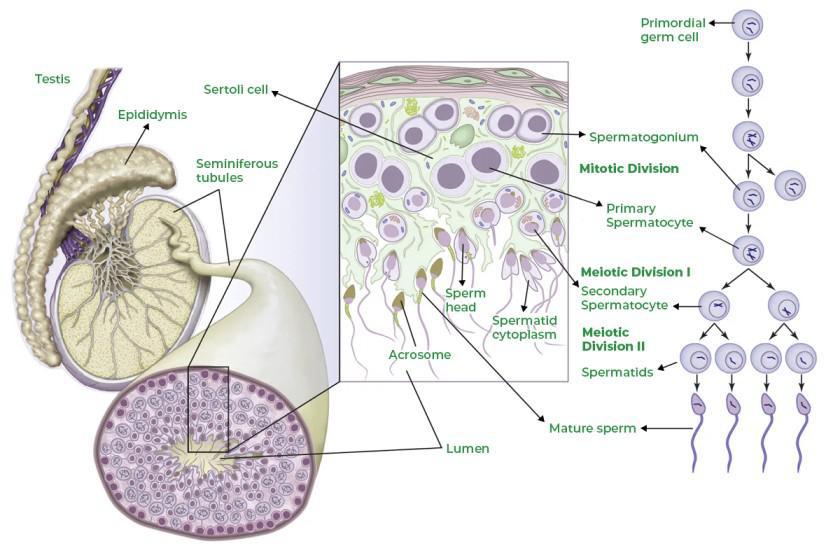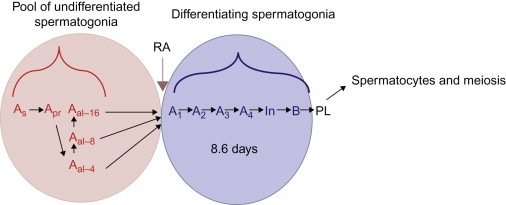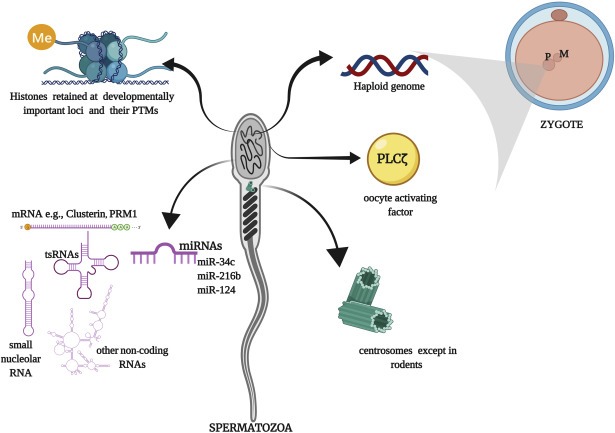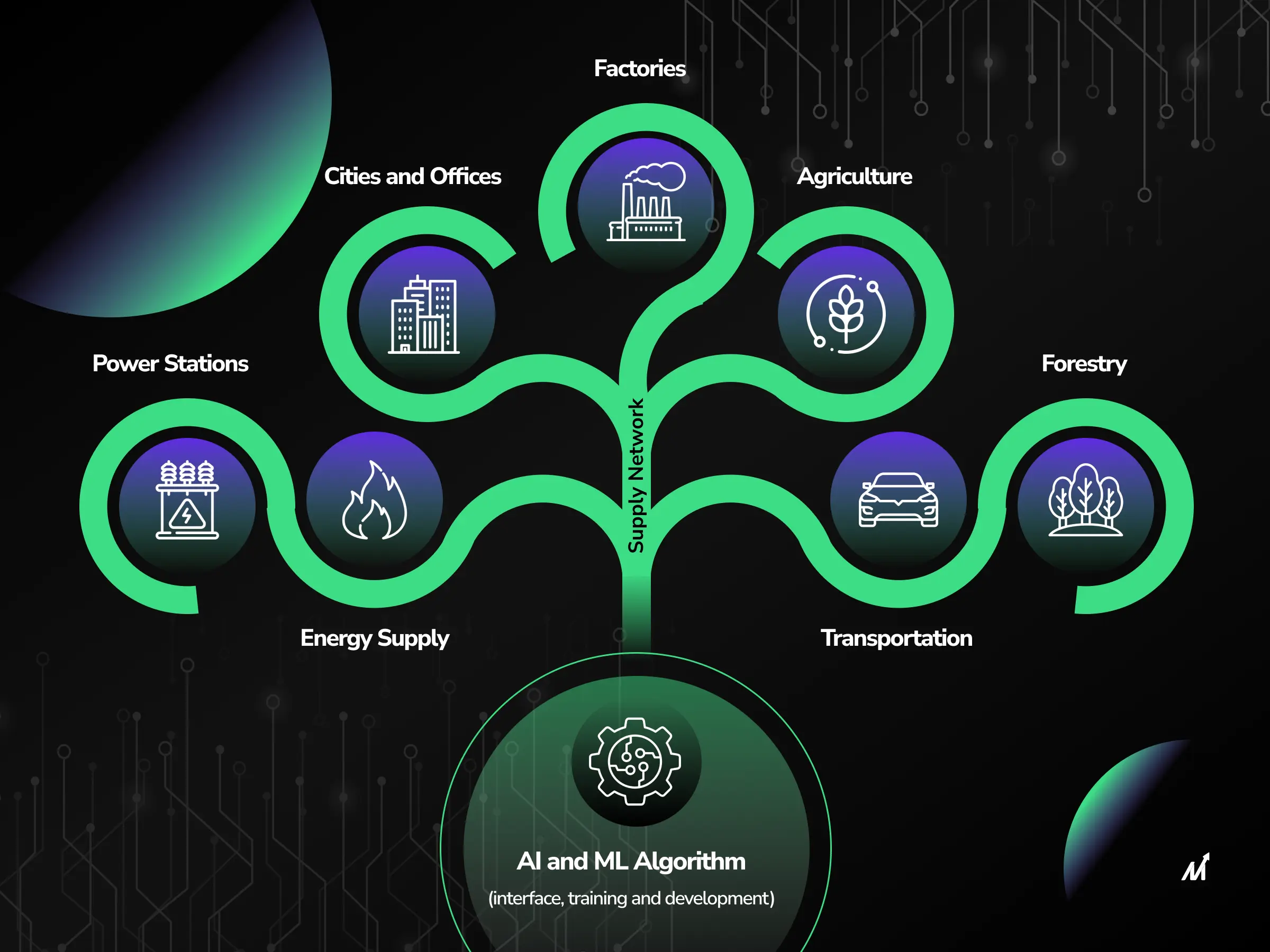Gametogenesis is the vital process by which haploid cells are formed from diploid cells through meiosis. In humans, it is responsible for the production of male and female gametes – sperm for males and ovum for females. Spermatogenesis is the process of sperm formation, while oogenesis is the process of ovum formation. During spermatogenesis, immature germ cells in the testes undergo a series of divisions to form mature sperm, while oogenesis in females involves the conversion of oogonia to mature ovum in the ovaries. In this article, we will delve into the structure of a human sperm and the intricate processes of spermatogenesis and oogenesis, shedding light on the crucial role of gametogenesis in sexual reproduction in humans.

Understanding Gametogenesis
Gametogenesis is a fundamental process in reproductive biology, involving the division of diploid cells to produce new haploid cells. This process is essential for the continuation of generations in humans.
Definition of Gametogenesis
Gametogenesis refers to the process by which haploid cells, such as sperm and ovum, are formed from diploid cells through meiosis. This process is crucial for sexual reproduction and the continuation of species.
Types of Gametes in Humans
In humans, two different types of gametes are present, namely sperm and ovum. Spermatogenesis is the process of sperm formation in males, while oogenesis is the process of ovum formation in females.
Spermatogenesis vs. Oogenesis
Spermatogenesis involves the production of sperms in males, with the process beginning at puberty in the testes. On the other hand, oogenesis leads to the formation of ova in females and begins in the fetus prior to birth. Both processes involve meiotic cell division and are regulated by reproductive hormones and the pituitary gland.
Spermatogenesis: Formation of Sperm
Initiation of Spermatogenesis in Males
Spermatogenesis is the complex process of sperm formation in males, beginning at puberty and continuing throughout adult life. It occurs in the testes, specifically in the seminiferous tubules, where a blood-testis barrier is formed by Sertoli cells to protect developing sperm from substances in the blood and the immune system.
The process begins with spermatogonia, which divide to replenish the pool of spermatogonia and eventually form mature sperm. Spermatids undergo spermiogenesis and travel through the seminiferous tubules to the epididymis for final maturation. Once ejaculated, sperm undergo capacitation in the female reproductive tract, allowing them to bind to the egg cell.

Stages of Spermatogenesis
Spermatogenesis is a multi-stage process that involves the production of immature germ cells called spermatogonia in the testes, which then undergo mitotic division to increase in number. These cells further undergo meiosis to produce haploid cells called secondary spermatocytes. These secondary spermatocytes then undergo a second meiotic division to form immature sperms or spermatids, which eventually transform into mature sperms through a process called spermiogenesis.
Role of Hormones in Spermatogenesis
Hormones such as Gonadotropin-releasing hormone (GnRH), Luteinizing hormone (LH), Follicle-stimulating hormone (FSH), and androgens play a crucial role in stimulating spermatogenesis in males. These hormones regulate the production and maturation of sperm cells, ensuring the continuous process of sperm formation throughout adult life.
Maturation and Release of Sperm
Once formed, mature sperm undergo final maturation in the epididymis before being released during ejaculation. They then travel through the female reproductive tract, undergoing capacitation, which allows them to bind to the egg cell for fertilization. This process of maturation and release of sperm is essential for successful sexual reproduction.
Oogenesis: Formation of Ova
Oogenesis is the process of egg formation in females and is a crucial part of gametogenesis. Unlike spermatogenesis, which begins at puberty in males, oogenesis starts in the foetus prior to birth. Primordial germ cells undergo replication by mitosis, with meiosis I starting before birth to form primary oocytes. There is a finite supply of ova, as further atresia (cell death) occurs during childhood, leaving approximately 40,000 eggs at puberty. Each month, a number of primary oocytes begin to mature, but only one reaches full maturation to become an oocyte. The primary oocytes undergo three stages – pre-antral, antral, and preovulatory – before ovulation occurs. The final stage of female gametogenesis involves the release of the mature ovum from the ovary and, if fertilization occurs, the completion of meiosis II to form a fertilized egg.
Onset of Oogenesis in Females
The onset of oogenesis in females occurs during fetal development, when millions of oogonia, or mother cells, are formed in the ovary. These mother cells undergo meiotic cell division, resulting in the formation of primary oocytes. At the onset of puberty, the primary oocytes complete meiosis and form secondary oocytes, which are then released from the ovary during the menstrual cycle. This complex process is regulated by various hormones, including GnRH, LH, FSH, and other reproductive hormones. Furthermore, the process of oogenesis involves the development of follicles in the ovary, culminating in the release of mature ova during ovulation. Overall, the onset and phases of oogenesis in females are intricately regulated and play a key role in the reproductive cycle.
Phases of Oogenesis
The primary oocytes undergo three stages – pre-antral, antral, and preovulatory – before ovulation occurs. Pre-antral phase is characterized by the development of primordial follicles, which contain primary oocytes. During the antral phase, the primary oocytes develop further within the follicles and undergo maturation. The preovulatory phase marks the final stage of oogenesis, during which a mature ovum is released from the ovary, ready for fertilization. This complex process is tightly regulated by female reproductive hormones and is essential for the continuation of the species.
Ovulation and the Release of Ovum
Ovulation, the release of the ovum from the Graafian follicle, marks the final phase of oogenesis in females. This process is controlled by the female reproductive hormone, which is stimulated by the pituitary gland. Ovulation is a crucial event in the reproductive cycle, as it enables the release of mature ova from the ovary, making it available for fertilization. The release of the ovum from the Graafian follicle is a highly coordinated process that involves the rupture of the follicle and the release of the mature ovum into the fallopian tube. This phase of oogenesis is essential for the continuation of the species and is a key event in the female reproductive cycle.
Structure of Human Sperm
Gametogenesis, which includes spermatogenesis and oogenesis, is a crucial process in humans that supports the continuity of generations. Spermatogenesis is the process of sperm formation in males, beginning with the production of immature germ cells in the testes. These cells undergo mitotic division and eventually develop into mature sperm through meiosis and spermiogenesis. On the other hand, oogenesis is the process of ovum formation in females, which starts with the formation of millions of oogonia in the ovary. These oogonia undergo meiotic cell division to produce mature ovum, with the release of the ovum from the Graafian follicle during the menstrual cycle. Both processes are regulated by reproductive hormones and play a crucial role in human reproduction.
Components of a Sperm Cell
In spermatogenesis, immature germ cells produced in the testes undergo mitotic division and eventually develop into mature sperm through a series of meiotic divisions. This process is stimulated by various hormones such as GnRH, LH, FSH, and androgens. On the other hand, oogenesis in females involves the formation of millions of oogonia in the ovary, which undergo meiotic cell division to produce mature ovum. The release of the ovum from the Graafian follicle during the menstrual cycle is controlled by reproductive hormones stimulated by the pituitary gland. Both spermatogenesis and oogenesis are essential for the production of male and female gametes, respectively, and are crucial for human reproduction.
Function of Each Component
Overall, gametogenesis, including spermatogenesis and oogenesis, is a complex and essential process in humans. Spermatogenesis involves the formation of mature sperm in males, while oogenesis leads to the production of mature ovum in females. Both processes are regulated by reproductive hormones and play a crucial role in human reproduction and the continuity of generations. Understanding the intricacies of gametogenesis is essential for comprehending the reproductive biology of humans and the processes involved in fertilization.
Role of Sperm in Fertilization
The data provided gives a detailed overview of the process of gametogenesis, focusing specifically on spermatogenesis and oogenesis. It explains how haploid cells are formed from diploid cells through meiosis, resulting in the production of spermatozoa in males and ova in females. The article covers the entire process of spermatogenesis, from the initial production of sperm in the testes to the final stages of maturation in the epididymis. It also delves into the intricacies of oogenesis, highlighting the differences from spermatogenesis and detailing the stages of development of ova in females, including the crucial process of fertilization. Additionally, the clinical relevance of gametogenesis is discussed, with a focus on conditions such as Polycystic Ovary Syndrome (PCOS) and the potential errors in meiosis that can lead to chromosomal abnormalities.
conclusion
In conclusion, gametogenesis is the process by which haploid cells, such as sperm and ovum, are formed from diploid cells through meiosis. Spermatogenesis is the formation of sperm in males, occurring in the testes and involving a complex process of meiotic division. Oogenesis, on the other hand, is the formation of ova in females, involving the development of follicles in the ovary. Both processes are crucial in supporting the continuity of generations in humans. Additionally, the structure of a human sperm involves the development of immature germ cells in the testes, which undergo mitotic division and meiotic divisions to eventually form mature sperm. Understanding the intricacies of gametogenesis and the structure of human sperm is essential in reproductive biology and understanding the process of human reproduction.










